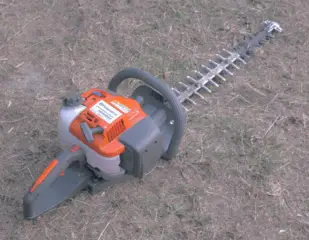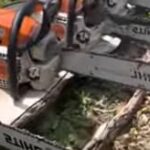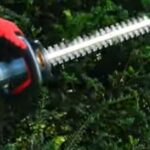As an Amazon Associate, this site earns commissions from qualifying purchases. For more information click here.
If you have been using hedge trimmers for a while, it has probably jammed on you once or twice. Usually it’s not a big deal, just pull the starter rope again and it works. But what if the tool is really stuck? There are many reasons why this can happen, but with the right approach you can fix these issues.
When a hedge trimmer gets stuck, it usually means the blades are clogged, need sharpening or have been damaged. If the blades are working properly, the air filters might need cleaning or there is a problem with the power supply.
Clean the Blades
By far this is the most likely reason why your hedge trimmer is jammed. As you trim and cut hedges, bushes, twigs etc. some of that will end up on the blades, clogging them up. Eventually it reaches the point when the blades can no longer move. But this is easy to fix.
To clean hedge trimmer blades you need:
- Safety goggles
- Gloves
- Lubricant (you can use the STA-BIL Blade Guard)
- Soapy water (if the blades are water resistant)
- Rags
Step 1. Turn the hedge trimmer off. Unplug from the power source if it is electrical. Put on your safety gear.
Step 2. Remove the blades. There should be a release button somewhere (check your manual). Press it and the blades will come off. If you are using an older model, hold the blades with your gloved hand and rock it back and forth. Eventually it will come loose.
Step 3. Once you remove the blades, you will see a lot of leaves, branches, twigs, dirt and other debris left behind. Wipe them off with a rag or any piece of cloth. Use damp cloth if the blades are water resistant.
Step 4. Put the blade on a flat surface. Look for signs of broken or bent teeth, rust or other indications of damage. If there is, you can either try to fix or replace the blades.
If the blades are fine, you can start cleaning. Wipe thoroughly until all the dirt is removed. Apply lubricant and wait for the blades to dry.
Step 5. Reinstall the blades and turn the hedge trimmer on. It should start right away and trim like before.
Damaged Blades
If you removed the blades and it has damage, what do you do? It depends on the severity of its condition.
Hedge trimmer blades get broken in many ways. The teeth could bend or snap off. The blades could have been broken after hitting a hard object.
Another way to damage the blades is by using it to cut materials they are not capable of. There are some hedge trimmers capable of cutting thick branches, but if yours is not one of them, do not force it.
Missing or broken blade teeth. If one or more teeth is missing you should replace the chain. With some hedge trimmers that is not possible and you have to replace the blade itself.
If the chain is replaceable, you just need to remove the blade and install the new teeth. The process varies so check your manual. Never use blades with broken or missing teeth because the blade movement will be unpredictable and risky.
Add More Lubricant
Lubricants are a must for hedge trimmers. When we think of lubrication, the first thing that comes to mind is the engine. True, engines need it to run smoothly and avoid early wear and tear. But blades need those as well.
Lubricate the engine and blades right before every use. There are many types of lubricants available, and application is easy. Regardless which you choose, regular use is necessary for it to work. Do not wait for the tool to stop working before you do it.
A running engine produces friction and this wears out the gears and other parts. Eventually the engine cannot run anymore and the trimmer grinds to a halt.
The same thing happens to the blades. Without lubricants, they cannot cut as smoothly and will wear out much faster.

Dirty Air Filter
The air filter keeps dirt from entering the system, but with time it gets clogged with debris. This prevents air from getting into the engine. Air is essential for ventilation otherwise the motor engine will overheat. If you are using a gas hedge trimmer, it will not start at all without air.
Air filters on trimmers such as the Proyama 42cc should be cleaned regularly. In most models, you have to remove a cover to gain access to the filter. Then you can clean the filter. If it is too dirty, consider replacing with a new one.
Most air filters are cleaned every 30-50 hours, but it depends on how dirty it gets. The environment plays a huge role obviously so only you can say when the filter needs cleaning. At least inspect it regularly when you do maintenance.
Problems with the Power Supply
Hedge trimmers can be classified into three types: gas, corded electric and cordless battery. If there is a problem with the power source, the tool will suddenly stop running. Here are the most common reasons.
Wrong fuel mixture. Most 2-stroke hedge trimmers use a 40:1 fuel mix ratio. That is, 3.2 oz. of oil per gallon of gas. If the ratio is off, the engine will probably jam at some point. The only solution is to empty the fuel tank and use a new mix.
Old fuel If you stored your hedge trimmer with a full tank and just took it out, the fuel might have dissipated, leaving behind a thick, viscous substance. You have to clean the fuel tank and replace it with new fuel.
No battery power. Cordless hedge trimmers will cease running if it runs out of energy. Make sure the battery is fully charged. If it is and the tool is still jammed, check the blades. If the blades are fine, the battery itself might be damaged.
Electrical problems. For jammed electric hedge trimmers, look into the blades first. If they are working, check the cord. Look for signs of wear and tear. There could be problems with the electrical circuits too. If that is the case, take the tool to a professional.
How to Prevent Hedge Trimmers from Jamming
The best way to deal with a jammed hedge trimmer is to prevent it from happening. There is no way to guarantee 100% this will not occur, but by following these tips you will minimize its chances.
Use Correctly
Read the manual and use it only as stated there. If the trimmer can only cut up to .0.75 inches, do not force it to cut a 1 inch branch. If the manual says to never use in extreme cold or heat, follow it.
A lot of hedge trimmer problems, including not moving LNK can arise from misuse. If you have a small trimmer and need to cut large branches, you can use shears, loppers or a saw. Be mindful of the specs – maximum cutting size, runtime, charging time, fuel type to use, etc. – so you can avoid mistakes.
Clean Regularly
Do not wait for the blades to lock up before cleaning them. Wipe them \after every use and do not leave dirt, branches or debris stuck between its teeth.
And do not just clean the blade. The entire trimmer should be cleaned and lubricated. When you are done, wait for the trimmer to dry before storing it. The most important parts are the engine, blades and the air filters. These are the places you should start looking in case the trimmer locks up.
Proper Storage. Store the tool in a watertight case. Keep it in a dry place like your garage or shed. If you are going to store it for months without use, empty the fuel tank. Some cordless trimmers can be stored fully charged, while other models prefer partial charge. Check the owner’s manual for information.

I love the outdoors and all the tools for maintaining gardens, yards and lawns. The only thing I am more passionate about is sharing what I know about garden and outdoor equipment.


